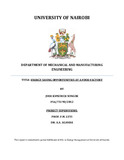| dc.description.abstract | A study on energy conservation and recovery measures was conducted at Premier Food
Industries to identify opportunities which would cut down on the overall energy cost. This was
guided by evaluation of energy cost distribution among the utilities in use. The biggest cost at
70% of the total energy cost was out of steam generation, 26% from electricity and the
remaining from diesel and propane gas.
The study narrowed down on the refrigeration container and steam systems. The aim was to
establish savings through insulation of condensate lines and pasteurization bath, evaluation of
the efficiency of existing steam line insulation, heat recovery from boiler blowdown, preheating
boiler make up water and pasteurization feed water using solar water heaters, covering the
open pasteurization bath while in operation and finally evaluating the performance of the
refrigeration container.
Through insulation, it was established that 90% of the heat loss could be conserved and the
payback period was estimated as 6 months. Most of the heat conserved was due to radiation
from the highly radiative surface which could be covered by a less radiative material. On the
other hand, the existing insulation on the steam lines was found to be 3% less efficient at base
surface temperature of 40°C. The pasteurization bath was determined to lose significant energy
estimated 92% of the total losses when operating with an open surface. The loss due to
evaporation could be eliminated by covering the surface.
Boiler blowdown had a high potential of recoverable energy discharged in the hot water at a
high pressure to the drains. By use of a blowdown vessel, 86% of the energy could be recovered
in flash steam and 14% from the discharge water. Blowdown flow rate of 138 kg/hr at 10bar
would yield a payback period estimated as 4 years due to the high initial cost for the system
despite the high returns realized.
Using solar water heaters to preheat water showed an extensive payback period determined at
minimum of 7 years which was lengthy. This was due to the high initial cost of the solar water
heaters. However, the system has potential considering Kenya’s location at a high insolation
region. Finally, the refrigerated container was evaluated to be inefficient due to air infiltration
at the door. This resulted in a non-uniform temperature profile which caused the system to run
longer to match the heat gain. It was also found that by raising the operation temperature from
-18°C to -10°C, 20% of the energy consumed was saved without any investment. | en_US |

